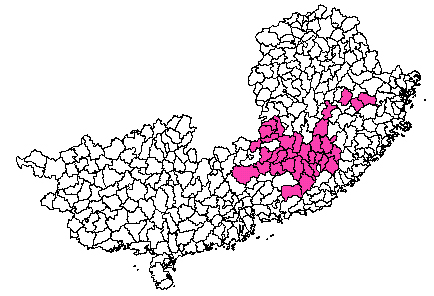
Here's a map using the data from the document above to show the counties of Guangdong, Fujian and Jiangxi identified as "All-Hakka Districts":
...and here's one with 'all Hakka' in red and 'part Hakka' in brown --with some 25 counties missing because their names don't quite match the census names:
Hakka Language and Population Profile Summary
Hakka: an important element of Chinese culture
Jiaying dialect speakers and Hakka Identity Past, present and future (Chunfat Lau and Pak-Sing Chow)
Hakka People (famous persons)
The Hakka People (historical background)
...their surprisingly egalitarian gender system. Since women were more highly valued than in other Chinese ethnic groups, female infanticide was much less widely practised. Among the Chinese populations of southeastern China, Hakkas aside, excess mortality of female infants and children typically yielded ratios of 120 men for every 100 women of marriageable age. To cull a fifth or a sixth of all females in a given generation is to reduce the number of mothers in the next by the same proportion, thereby radiclly slowing population growth. But with their preference for gender-balanced as opposed to male-heavy offspring sets, the Hakkas effectively sidestepped this growth-suppressing feathure of the usual Chinese demographic regime. In short, it is quite plausible that population growth was extraordinarily high in Hakkaland, providing a major push to the out-migration that began in the sixteenth century.and further:
(from G. William Skinner's Introduction to Leong's Migration and Ethnicity in Chinese History: Hakkas, Pengmin, and their neigbors [1997], pg. 6)
...the distinctive gender system of the Hakkas developed in response to male itinerancy and sojourning ...Hakka women did not bind their feet; they engaged in physical labor outside the home as normative expectation and without community stigma; they went to market as vendors and buyers with the same freedom as men ...a distinctly attenuated patriarchy (pg. 9)